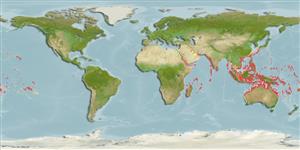Common names from other countries
>
Eupercaria/misc (Various families in series Eupercaria) >
Labridae (Wrasses) > Corinae
Etymology: Halichoeres: Greek, als, alis = salt + Greek, choiros = pig (Ref. 45335).
More on author: Lacepède.
Environment: milieu / climate zone / depth range / distribution range
Ecologia
marinhas associadas(os) a recifes; intervalo de profundidade 0 - 40 m (Ref. 128797), usually 1 - 30 m (Ref. 27115). Tropical; 24°C - 28°C (Ref. 27115); 32°N - 28°S, 34°E - 134°W
Indo-Pacific: Red Sea south to Sodwana Bay, South Africa and east to the Line, Marquesas and Tuamoto islands, north to southern Japan, south to the southern Great Barrier Reef.
Length at first maturity / Tamanho / Peso / Idade
Maturity: Lm 12.8 range ? - ? cm
Max length : 27.0 cm TL macho/indeterminado; (Ref. 2334)
Descrição breve
Chaves de identificação | Morfologia | Morfometria
Espinhos dorsais (total) : 9; Raios dorsais moles (total) : 11; Espinhos anais: 3; Raios anais moles: 11. Some geographical variations between Indian and Pacific Ocean and Red Sea. Adults with one or two yellow saddles over the back and sometimes with small black spot on upper peduncle. Small juveniles black and white, gradually changing with growth to adult pattern (Ref. 48636).
Inhabits sand patches of lagoon and seaward reefs to at least 30 m (Ref. 1602); also on slopes to moderate depths along drop-offs (Ref. 48636). Juveniles common at the bottom of surge channels (Ref. 9710). Feeds mainly on hard-shelled prey, including mollusks, crustaceans and sea urchins (9823).
Life cycle and mating behavior
Maturities | Reprodução | Spawnings | Egg(s) | Fecundities | Larvas
Distinct pairing during breeding (Ref. 205).
Randall, J.E., G.R. Allen and R.C. Steene, 1990. Fishes of the Great Barrier Reef and Coral Sea. University of Hawaii Press, Honolulu, Hawaii. 506 p. (Ref. 2334)
Categoria na Lista Vermelha da IUCN (Ref. 130435)
CITES (Ref. 128078)
Not Evaluated
Ameaça para o homem
Harmless
Utilização humana
Pescarias: pouco comercial; Aquário: Espécies comerciais
Ferramentas
Relatórios especiais
Descarregue XML
Fontes da internet
Estimates based on models
Preferred temperature (Ref.
115969): 24.8 - 29, mean 27.6 (based on 978 cells).
Phylogenetic diversity index (Ref.
82804): PD
50 = 0.5000 [Uniqueness, from 0.5 = low to 2.0 = high].
Bayesian length-weight: a=0.00933 (0.00538 - 0.01619), b=3.09 (2.94 - 3.24), in cm Total Length, based on LWR estimates for this species & Genus-body shape (Ref.
93245).
Nível Trófico (Ref.
69278): 3.4 ±0.42 se; based on food items.
Resiliência (Ref.
120179): Elevada, tempo mínimo de duplicação da população menor que 15 meses (K=0.7).
Fishing Vulnerability (Ref.
59153): Low vulnerability (21 of 100).
